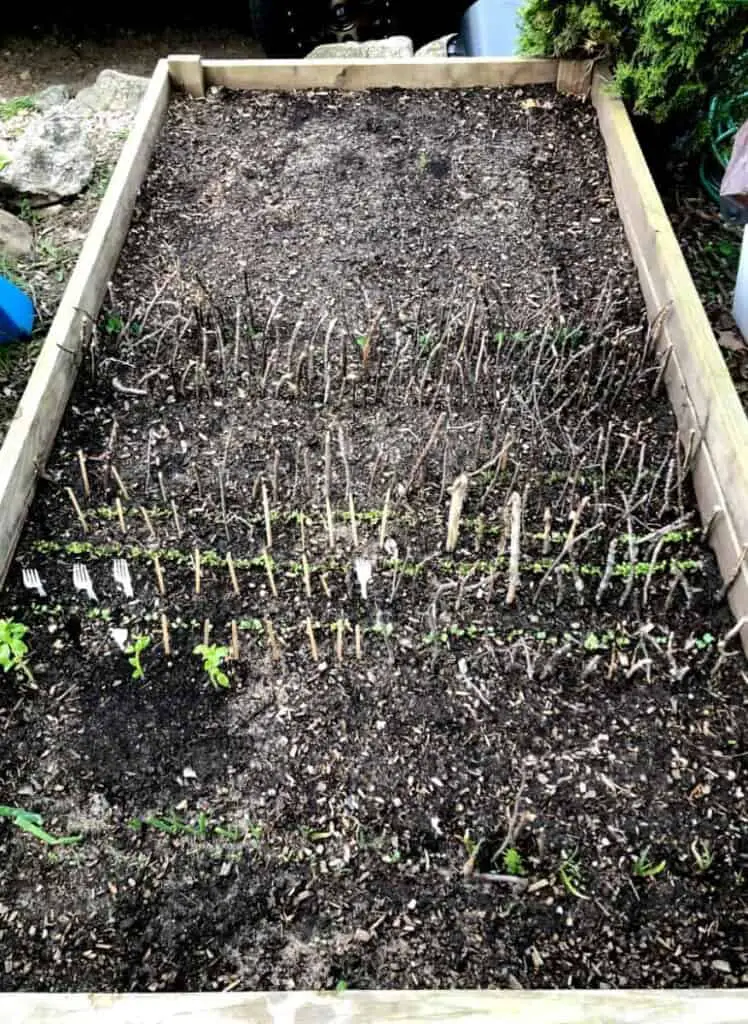Starting a vegetable garden is one of the most exciting tasks there is. Watching seeds sprouting and sending out new fresh green leaves is so thrilling to watch. But when is the right time to start those seeds sprouting? There are some plants you can start indoors already in February under grow lights. I wait till the end of March to plant seeds of cold hardy vegetables directly in the ground in my raised beds. The best month for me to start my garden in zone 6 is the end of March, but it might be different for you. Let me help you to find out what is the best month for your to plant your pantry-stocking garden.
The best month to start your vegetable garden will most probably be March and April depending on your hardiness zone. Check your soil conditions and if your soil is thawed, not muddy or overly wet, warmed up, and workable it might be a good time for you to start your garden.

How to know when to start your garden
The best way to find out whether your garden is ready to be planted is to check your soil. When snow melts and your soil is thawed, not muddy or overly wet, warmed up, and workable you should be able to start your garden.
The soil in raised beds and containers warmers up faster than in inground gardens.
One of the most important pieces of information for every gardener is to know their own hardiness zone. If you don’t already know what is your hardiness zone, please find out by visiting the USDA plant hardiness zone by clicking on this link which will guide you to the USDA hardiness zone map. Enter your zip code into the search box in the upper-left of the map and find your location and hardiness according to the color key.
Knowing your zone will help you choose when and what to sow and plant in your garden. It will also help you indicate when is your first and last frost date.
What vegetables to grow
After the winter, it’s best to start with plants that like and thrive in cooler temperatures. These vegetables are called cold hardy vegetables. These vegetables are also able to withstand frost. Among the hardiest vegetables are leeks, rhubarb, broccoli, kohlrabi, kale, cabbage, Brussel sprouts, arugula, radish, mustard greens, asparagus, beets, chives, carrots, cauliflower, Swiss chard, lettuce, onions, parsnips, and peas.

Prepare for frost with frost protection covers
When planting in March and April, most gardeners are prepared for frost by covering their plants, and seedlings with frost protection.
In my garden, I use fabric covers, but if you don’t have any, your old bed sheets, towels, newspapers, and even cardboard would work. If you plan to keep your garden planted every year I would strongly recommend fabric covers. I buy them in bulk and cut them to fit my raised beds. I place them in after I plant seeds or seedlings and just let them sit on my garden beds. Covers are very versatile and serve me in a number of ways. They not only protect my plants from frost but also help me to bring my soil temperature up and serve as pest protection as I battle chipmunks and squirrels that like to dig out the seeds and eat them. Row covers also keep rabbits and deer out.
Prepare your soil
If you didn’t prepare your soil before winter, you need to do so now, before you saw seeds or plant your seedlings. Check if your soil is ready to be worked. If your soil is still frozen, it doesn’t matter if it’s March or April, you need to wait for it to thaw. Once it’s thawed, your soil should become workable before tilling. Check how compact your soil is. If it is compact and not crumbly you would need to till it to aerate and soften it. If your soil needs tilling wait till it’s thawed, and contains proper moisture. Do not till when very wet and muddy. Tilling soil in such a condition could result in you compacting it or breaking it into large chunks that would later dry into large hard chunks, not soft and aerated soil.
Once your soil is the soft and right consistency, it’s time to amend it with organic matter such as compost, worm casting, aged chicken, or horse manure. If your soil lacks aeration and needs to improve water permeability you might need to add inorganic amendments like dolomite lime, sand, vermiculite, perlite, and ash. To increase the mineral richness of your soil you can amend it with rock minerals using rock dust.
Once your soil is prepared, you are now ready to sow the seeds directly in the soil or plant your seedlings.
What vegetables to sow in spring in zone 6
How do I start a pantry-stocking garden?

